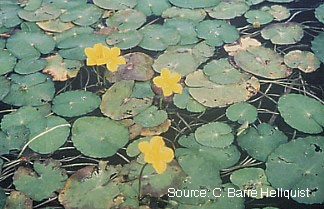Community News

Brazilian Waterweed
Description: Underwater stems rise from trailing, unbranched roots. Bright to dark green leaves are thickly arranged in groups of 4 to 6 leaves along slender stems. (Note: some lower leaves may occasionally occur in opposite pairs or in groups of 3 leaves.) The small flowers (2 cm in diameter) have three white petals and a yellow center, and rise just above or at the surface on slender stalks. Unlike its invasive look alike hydrilla, Brazilian waterweed does not produce bulb-like structures.
Habitat: Brazilian waterweed is found in the underwater plant community. It may grow in bottoms with sand, mud or stone to depths of 6.5 meters. A resilient plant, most of its biomass is produced near the water surface. Infestations of Brazilian waterweed may occur in large thickly rooted stands, and drifting mats.
Annual Cycle: Brazilian waterweed is a rooted, underwater perennial. Areas on the stems play an important role in food storage and reproduction. Unusual roots and branches are both produced from the stem. If a piece of Brazilian waterweed does not have a double node, it cannot grow into a new plant. Regrowth of piece of the plant containing a double node is the only means for reproduction. Only male flowers are present on plants found in the US, therefore no seeds are produced. Brazilian waterweed prefers moderate water temperatures, and optimum growth occurs in the spring and fall. During the summer growth may slow, or cease completely. Plants will die back to their roots in the winter.
Origin and U.S. Range: Brazilian waterweed is native to South America. It has been widely distributed in the United States (usually under the name “anacharis”) as an aquarium plant and a beneficial oxygenator for water nurseries. Brazilian waterweed is currently present in many parts of the US including the nearby states of New Hampshire, Massachusetts, Vermont and New York.
Look a likes: May be confused with hydrilla, native waterweeds, water starworts, and mare’s tail.
